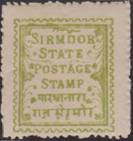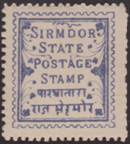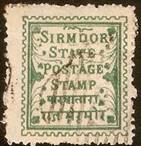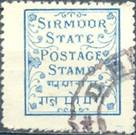India-Sirmoor stamps
P=have O=don’t have it
Sirmoor (aka
Sirmour, Sirmur) was a
small Princely state in northern India under the protection of the British
Empire. It is currently located in the southeast corner of the state of
Himachal Pradesh in India.
Sirmoor
was founded in Nahan, the capital city, in 1616 by
Raja Karam Parkash, as part
of the Mughal Empire. Raja Parkash
aided the Mughal Emperor in conquering Srinagar in Garhwal, where he was awarded additional land for expanding
the Kingdom of Sirmoor. For the next 150 years, the
Raja’s of Sirmoor continued to aid the Mughal Empire, and Simoor grew in
its control of surrounding feudatory lands.
Karam Parkash II, who ascended the throne in 1793, was a very
weak and poor ruler, and eventually Sirmoor lost
control of all of its feudatories. Things collapsed when Karam’s
younger brother led a rebellion in 1803 and attempted to seize the throne. To
stave off the rebellion, Karam II appealed to the Gurkhas of Nepal, who promptly sent a large army into Sirmoor. After the rebels were expelled, the Gurkhas refused to restore Karam Parkash II to the throne, instead they annexed all of the
lands of Sirmoor into the Kingdom of Nepal and Karam II went into exile at Buria.
As
the Kingdom of Nepal continued expanding into other areas including Sikkim, Kamaon and Garhwal, it was
inevitable that they would come into conflict with the British who had their
own aggressive expansion plans. This resulted in Britain declaring war against
Nepal in 1814. Taking advantage of the situation, Karam’s
second wife, Guleri Raniji Sahiba contacted the British and requested aid against the Gurkhas. The British sent a force to Simoor
and eventually was able to drive out the Nepalese in 1815.
Karam Parkash II was not reappointed as leader, rather his son Fateh Parkash was crowned as Raja
at age 6, and his mother Guleri Raniji
Sabiah was appointed as regent. He came of age in
1827 assuming full responsibilities.
While
Sirmoor was a small state in British India, most of
its Rajas were able rulers and fully supported the British Crown in the various
conflicts and wars across India and even WW1 and WW2. They were well know for
providing some of the best miners and sappers for aiding sieges. During the
Indian Rebellion of 1858, The Sirmoor Rifles (a
Battalion of highly trained Gurkha soldiers) remained
loyal to the British. The Sirmoor Battalion was
presented with the Queen’s Truncheon and the Sirmoor
Rifles became the 2nd Gúrkha Regiment. In
1876, the Sirmoor Rifles became Edward VII’s (who was
Prince of Wales at the time) own Gurkha Regiment.
This honor continued when he became king.
Sirmoor
remained a Princely state until Maharaja Sir Rajendra
Prakash Bahadur signed the
Instrument of Merger with the Dominion of India on 13 Mar, 1948, and merged his
state into the Punjab and Eastern States Union on 15 Apr, 1948.
For
India States, stamp collectors divide the states that issued stamps into two
camps. Feudatory States ran their own post and issued stamps which were valid
within that particular state. Convention states had an agreement (aka
convention) with the British India postal system to handle internal postage,
and overprinted stamps of British India with the particular state.
Sirmoor
is considered a Feudatory state. Sirmoor issued its
first stamp in 1879. The stamp was simply designed with the words “Sirmoor State Postage Stamp” written in English and Hindi
surrounded by vines and flowers. There were two issues of the 1p stamp, one
printed in green on wove paper and the second printed in blue on laid paper.
In
1885, a set of 5 stamps were issued featuring Raja Shamsher
Prakash Bahadur (pictured
above). In 1893, Sirmoor reissued the “Sirmoor State Postage Stamp” design, with the key
difference being printed perforations around the central design.
In
1895, Sirmoor issued a very attractive set of stamps
featuring an elephant. The stamps, issued in 8 denominations, were inscribed
“SIRMOOR POSTAGE AND INLAND REVENUE”. Finally, in 1899, stamps featuring the
new Raja, Sir Surendar Bikram
Prakash were issued, as his father died in 1898.
Official
Stamps were also issued in 1890-92. The stamps overprinted the 1885 Raja Shamsher issues with: “On S. S. S.” and was used for
official correspondence.
Stamps
of Sirmoor were only good for postage within the
state, and became obsolete in 1901.
http://www.dcstamps.com/sirmoor-princely-state-of-india-1815-1948/
A Feudatory state in the Punjab
District of India.


Scott: #9-10O
Thanks to Lloyd Gilbert for the scans
Issued: 1893
Definitive
 Inside #9: India-Sirmoor
#1O(B)
Inside #9: India-Sirmoor
#1O(B)
 Inside #10: India-Sirmoor
#2O(B)
Inside #10: India-Sirmoor
#2O(B)
Best website
related:
![]()